Exploring the Possibility of Using Ionic Copolymer Poly (Ethylene-co-Methacrylic) Acid as Modifier and Self-Healing Agent in Asphalt Binder and Mixture
Abstract
1. Introduction
2. Materials
2.1. Virgin Binder and Aggregate
2.2. Modifiers
2.3. Binder Preparation
2.4. Mixture Preparation
3. Methodology
3.1. Binder Testing and Analysis
3.1.1. Binder Master Curves and Glover-Rowe Parameter
3.1.2. Ductility Test
3.1.3. Fluorescence Microscopy Test
3.1.4. Scanning Electron Microscope (SEM) Test
3.2. Mixture Testing
3.2.1. Complex Modulus Test
3.2.2. Thermal Stress-Restrained Specimen Test
3.2.3. Low-Temperature Fracture Test
3.2.4. Fatigue–Healing–Fatigue Test
4. Results and Discussion
4.1. Binder Testing Results and Discussion
4.1.1. Complex Modulus Master Curves
4.1.2. Glover–Rowe Parameter
4.1.3. Ductility Healing Rate
4.1.4. Fluorescence Micrographs
4.1.5. SEM Test Analysis
4.2. Mixture Testing Results and Discussion
4.2.1. Stiffness—Dynamic Modulus
4.2.2. Relaxation—Phase Angle
4.2.3. Cracking Behavior at Low Temperature
4.2.4. Self-healing Capacity
5. Summary and Conclusions
- The conventional tests, including softening point, equivalent softening point (T800), and kinematic viscosity (135 °C) showed that the contents of 4% EMAA and 3% SBR can increase the physical properties and decrease the costs;
- 4%EMAA was effective in improving the complex shear modulus of binder. 3%SBR showed little effect on complex shear modulus of asphalt mixtures compared with virgin binder, however it was more effective at high temperatures. The G-R parameter results showed that 4%EMAA has a negative effect on anti-cracking ability of binder. 4%EMAA/3%SBR may show the best anti-cracking ability on site;
- The ductility test results showed that EMAA had great potential to improve the self-healing behavior of binder, which was more evident in the ductility test of EMAA compound SBR-modified binder. What is more, the EMAA/SBR/asphalt system showed the best homogeneity and compatibility among four kinds of binders based on the fluorescence micrographs. Also, the anti-fracture property and the mechanical strength of EMAA/SBR compound-modified binder improved based on the SEM images. The fatigue–healing–fatigue test results showed that the fatigue life of EMAA/SBR compound-modified mixture had been significantly extended with a 24 h healing interval;
- The results of dynamic modulus testing showed that the modified asphalt mixtures are stiffer than virgin mixture, while for SBR-modified asphalt mixture, the improvement was not found to be significant. The results of phase angle showed that EMAA had a negative effect on anti-cracking ability. However, the phase angles of EMAA/SBR compound-modified mixture was slightly greater than SBR-modified mixture, indicating better resistance to cracking;
- According to the results of fracture temperature and fracture stress, the EMAA/SBR compound-modified asphalt showed the best low-temperature cracking resistance. The fracture strain tolerance (FST) was selected as the parameter instead of fracture energy. The results showed that EMAA/SBR compound-modified mixture had the greatest FST value, indicating the best crack resistance at low-temperatures. In addition, the EMAA/SBR compound-modified mixture had the lowest variability of FST value.
Author Contributions
Funding
Acknowledgments
Conflicts of Interest
References
- Agzenai, Y.; Pozuelo, J.; Sanz, J.; Perez, I.; Baselga, J. Advanced self-healing asphalt composites in the pavement performance field: Mechanisms at the nano level and new repairing methodologies. Recent Pat. Nanotechnol. 2015, 9, 43. [Google Scholar] [CrossRef] [PubMed]
- Baldino, N.; Gabriele, D.; Rossi, C.O.; Seta, L.; Lupi, F.R.; Caputo, P. Low temperature rheology of polyphosphoric acid (PPA) added bitumen. Constr. Build. Mater. 2012, 36, 592–596. [Google Scholar] [CrossRef]
- Becker, Y.; Méndez, M.P.; Rodríguez, Y. Polymer modified asphalt. Vis. Tecnol. 2001, 9, 39–50. [Google Scholar]
- Zhang, F.; Hu, C. Influence of aging on thermal behavior and characterization of SBR compound modified asphalt. J. Therm. Anal. Calorim. 2014, 115, 1211–1218. [Google Scholar] [CrossRef]
- Kim, Y.R.; Little, D.N.; Lytton, R.L.; D’Angelo, J.; Davis, R.; Rowe, G. Use of dynamic mechanical analysis (DMA) to evaluate the fatigue and healing potential of asphalt binders in sand asphalt mixtures. J. Assoc. Asph. Paving Technol. 2002, 71, 176–206. [Google Scholar]
- Little, D.N.; Lytton, R.L.; Williams, D.; Kim, Y.R. An analysis of the mechanism of microdamage healing based on the application of micromechanics first principles of fracture and healing. J. Assoc. Asph. Paving Technol. 1999, 68, 501–542. [Google Scholar]
- Karki, P.; Li, R.; Bhasin, A. Quantifying overall damage and healing behaviour of asphalt materials using continuum damage approach. Int. J. Pavement Eng. 2015, 16, 350–362. [Google Scholar] [CrossRef]
- Sun, D.; Sun, G.; Zhu, X.; Guarin, A.; Li, B.; Dai, Z.; Ling, J. A comprehensive review on self-healing of asphalt materials: Mechanism, model, characterization and enhancement. Adv. Colloid Interface Sci. 2018, 256, 65–93. [Google Scholar] [CrossRef]
- Qiu, J.; Van de Ven, M.; Wu, S.; Yu, J.; Molenaar, A. Evaluating self healing capability of bituminous mastics. Exp. Mech. 2012, 52, 1163–1171. [Google Scholar] [CrossRef]
- Liu, Q.; Schlangen, E.; van de Ven, M. Induction healing of porous asphalt concrete beams on an elastic foundation. J. Mater. Civ. Eng. 2012, 25, 880–885. [Google Scholar] [CrossRef]
- Dai, Q.; Wang, Z.; Hasan, M. Investigation of induction healing effects on electrically conductive asphalt mastic and asphalt concrete beams through fracturehealing tests. Construct. Build. Mater. 2013, 49, 729–737. [Google Scholar] [CrossRef]
- Apostolidis, P.; Liu, X.; Scarpas, A.; Kasbergen, C.; van de Ven, M. Advanced evaluation of asphalt mortar for induction healing purposes. Construct. Build. Mater. 2016, 126, 9–25. [Google Scholar] [CrossRef]
- Peinado, F.; Medel, E.; Silvestre, R.; Garcia, A. Open-grade wearing course of asphalt mixture containing ferrite for use as ferromagnetic pavement. Compos. Part B Eng. 2014, 57, 262–268. [Google Scholar] [CrossRef]
- Micaelo, R.; Al-Mansoori, T.; Garcia, A. Study of the mechanical properties and selfhealing ability of asphalt mixture containing calcium-alginate capsules. Construct. Build. Mater. 2016, 123, 734–744. [Google Scholar] [CrossRef]
- Li, R.; Zhou, T.; Pei, J. Design, preparation and properties of microcapsules containing rejuvenator for asphalt. Construct. Build. Mater. 2015, 99, 143–149. [Google Scholar] [CrossRef]
- Trask, R.S.; Williams, H.R.; Bond, I.P. Self-healing polymer composites: Mimicking nature to enhance performance. Bioinspir. Biomim. 2007, 2, 1–9. [Google Scholar] [CrossRef]
- Meure, S.; Wu, D.; Furman, S. Polyethylene-co-methacrylic acid healing agents for mendable epoxy resins. Acta Mater. 2009, 57, 4312–4320. [Google Scholar] [CrossRef]
- Meure, S.; Furman, S.; Khor, S. Poly[ethylene-co-(methacrylic acid)] healing agents for mendable carbon fiber laminates. Macromol. Mater. Eng. 2010, 95, 420–424. [Google Scholar] [CrossRef]
- Pingakararwat, K.; Wang, C.; Varley, R.J.; Mouritz, A.P. Self-healing of delamination fatigue cracks in carbon fibre–epoxy laminate using mendable thermoplastic. J. Mater. Sci. 2012, 47, 4449–4456. [Google Scholar] [CrossRef]
- Wang, R.; Wan, C.; Zhang, Y. Study on PE-HD/wood fiber composites compatibilized with ethylene methacrylic acid copolymer. China Plast. 2005, 11, 63–66. [Google Scholar]
- Zhao, B.; Zhao, S.; Zhang, H.; Su, M. Properties and mechanism of composite asphalt modified by nano-CaCO3/SBR. J. Chang’an Univ. 2017, 37, 15–22. [Google Scholar]
- JTG E20-2011. Standard Test Methods of Bitumen and Bituminous Mixtures for Highway Engineering; Ministry of Transport of the People’s Republic of China: Beijing, China, 2011.
- JTG F40-2004. Technical Specification for Construction of Highway Asphalt Pavements; Ministry of Transport of the People’s Republic of China: Beijing, China, 2004.
- Booshehrian, A.; Mogawer, W.S.; Bonaquist, R. How to construct an asphalt binder master curve and assess the degree of blending between RAP and virgin binders. J. Mater. Civ. Eng. 2013, 25, 1813–1821. [Google Scholar] [CrossRef]
- Glover, C.; Davison, R.; Domke, C.; Ruan, Y.; Juristyarini, P.; Knorr, D.; Jung, S. Development of a New Method for Assessing Asphalt Binder Durability with Field Evaluation; Publication FHWA-TX-05-1872-2; National Research Council: Washington, DC, USA, 2005. [Google Scholar]
- Aderson, R.M.; King, G.; Hanson, D.; Blankenship, P.B. Evaluation of the Relationship between Asphalt Binder Properties and Non-Load Related Cracking. J. Assoc. Asph. Paving Technol. 2011, 80, 649–662. [Google Scholar]
- Rowe, G.M.; King, G.; Anderson, M. The Influence of Binder Rheology on the Cracking of Asphalt Mixes on Airport and Highway Projects. J. Test. Eval. 2014, 42, 1063–1072. [Google Scholar] [CrossRef]
- Dong, F.; Zhao, W.; Zhang, Y.; Wei, J.; Fan, W.; Yu, Y.; Wang, Z. Influence of SBS and asphalt on SBS dispersion and the performance of modified asphalt. Constr. Build. Mater. 2014, 62, 1–7. [Google Scholar] [CrossRef]
- AASHTO. TP 10-93, Standard Test Method for Thermal Stress Restrained Specimen Tensile Strength; Provincial Standards; American Association of State Highway and Transportation Officials (AASHTO): Washington, DC, USA, 1993. [Google Scholar]
- Li, X.J.; Marasteanu, M.O. Using semi circular bending test to evaluate low temperature fracture resistance for asphalt concrete. Exp. Mech. 2010, 50, 867–876. [Google Scholar] [CrossRef]
- Al-Qadi, I.; Ozer, H.; Lambros, J.; Khatib, A.; Singhvi, P.; Khan, T.; Rivera, J.; Doll, B. Testing Protocols to Ensure Performance of High Asphalt Binder Replacement Mixes Using RAP and RAS; Report No. FHWA-ICT-15-017; Illinois Center for Transportation: Rantoul, IL, USA, 2015. [Google Scholar]
- Pérez-Jiménez, F.; Botella, R.; Martínez, A.H.; Miró, R. Analysis of the Mechanical Behaviour of Bituminous Mixtures at Low Temperatures. Constr. Build. Mater. 2013, 46, 193–202. [Google Scholar] [CrossRef]
- Zhu, Y.; Dave, V.E.; Rahbar-Rastegar, R.; Daniel, J.S.; Zofka, A. Comprehensive Evaluation of Low Temperature Fracture Indices for Asphalt Mixtures. Road. Mater. Pavement Des. 2017, 18 (Suppl. 4), 467–490. [Google Scholar] [CrossRef]
- Jacues, C.; Daniel, J.S.; Bennert, T.; Reinke, G.; Norouzi, A.; Ericson, C.; Mogawer, W.; Kim, Y.R. Effect of silo storage time on the characteristics of virgin and reclaimed asphalt pavement mixtures. Transport. Res. Rec. 2016, 2573, 76–85. [Google Scholar] [CrossRef]
- Liang, M.; Xin, X.; Fan, W.; Sun, H.; Yao, Y.; Xing, B. Viscous properties, storage stability and their relationships with microstructure of tire scrap rubber modified asphalt. Constr. Build. Mater. 2015, 74, 124–131. [Google Scholar] [CrossRef]
- Hao, P.; Zhai, R.; Zhang, Z.; Cao, X. Investigation on performance of polyphosphoric acid (PPA)/SBR compound-modified asphalt mixture at high and low temperatures. Road Mater. Pavement Des. 2019, 20, 1376–1390. [Google Scholar] [CrossRef]
- Zhang, F.; Yu, J. The research for high-performance SBR compound modified asphalt. Constr. Build. Mater. 2010, 24, 410–418. [Google Scholar] [CrossRef]
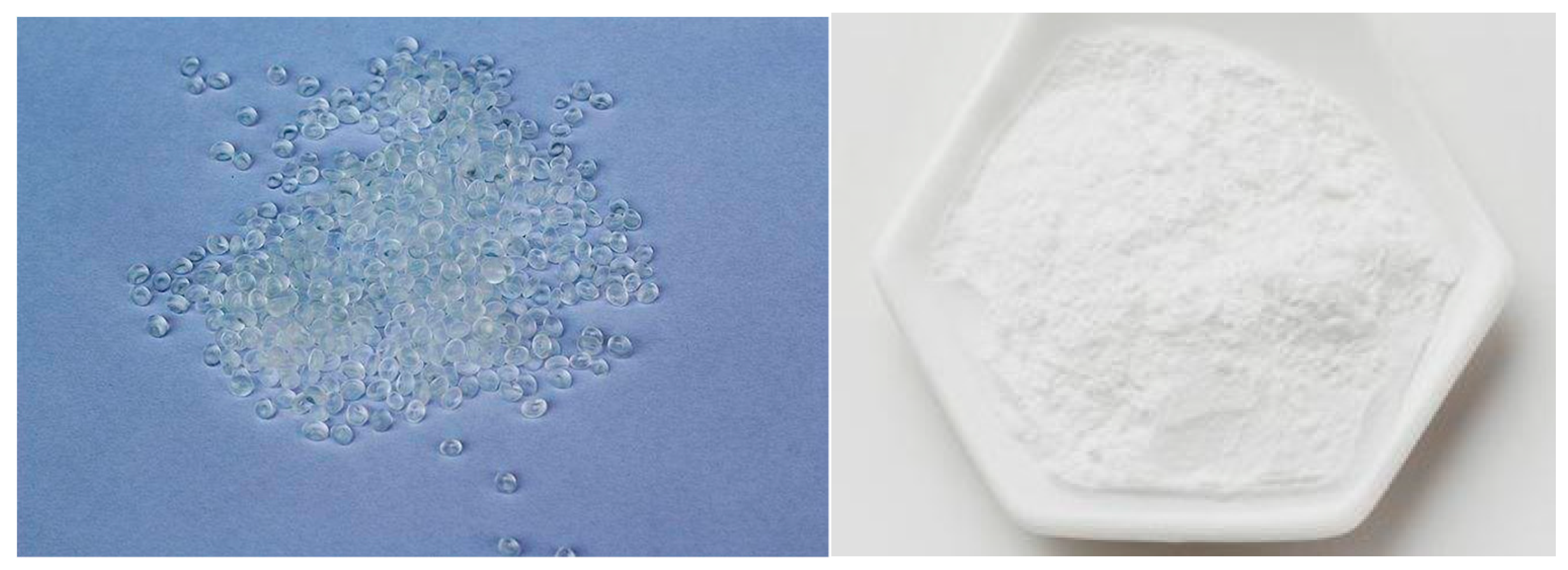
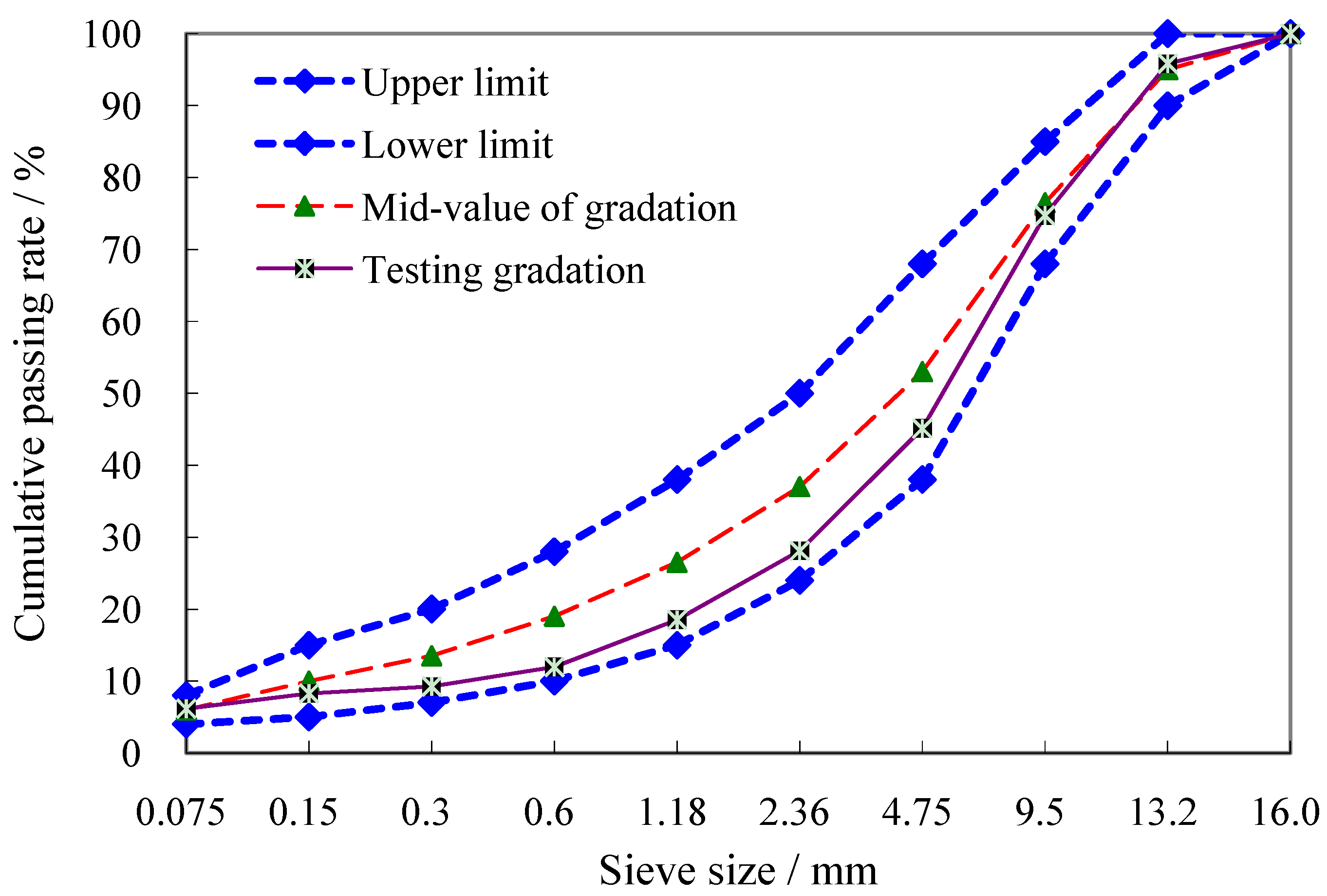
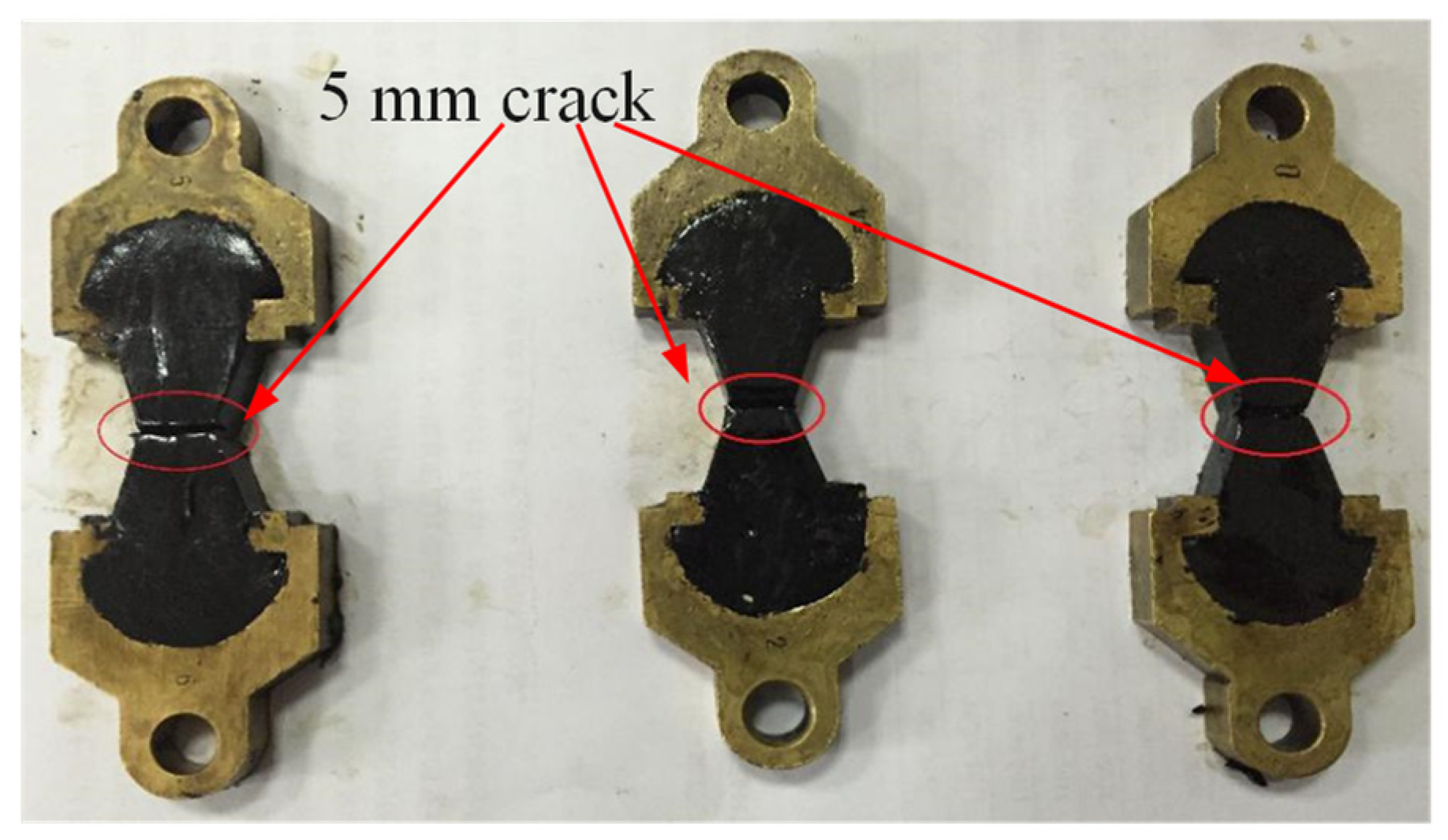
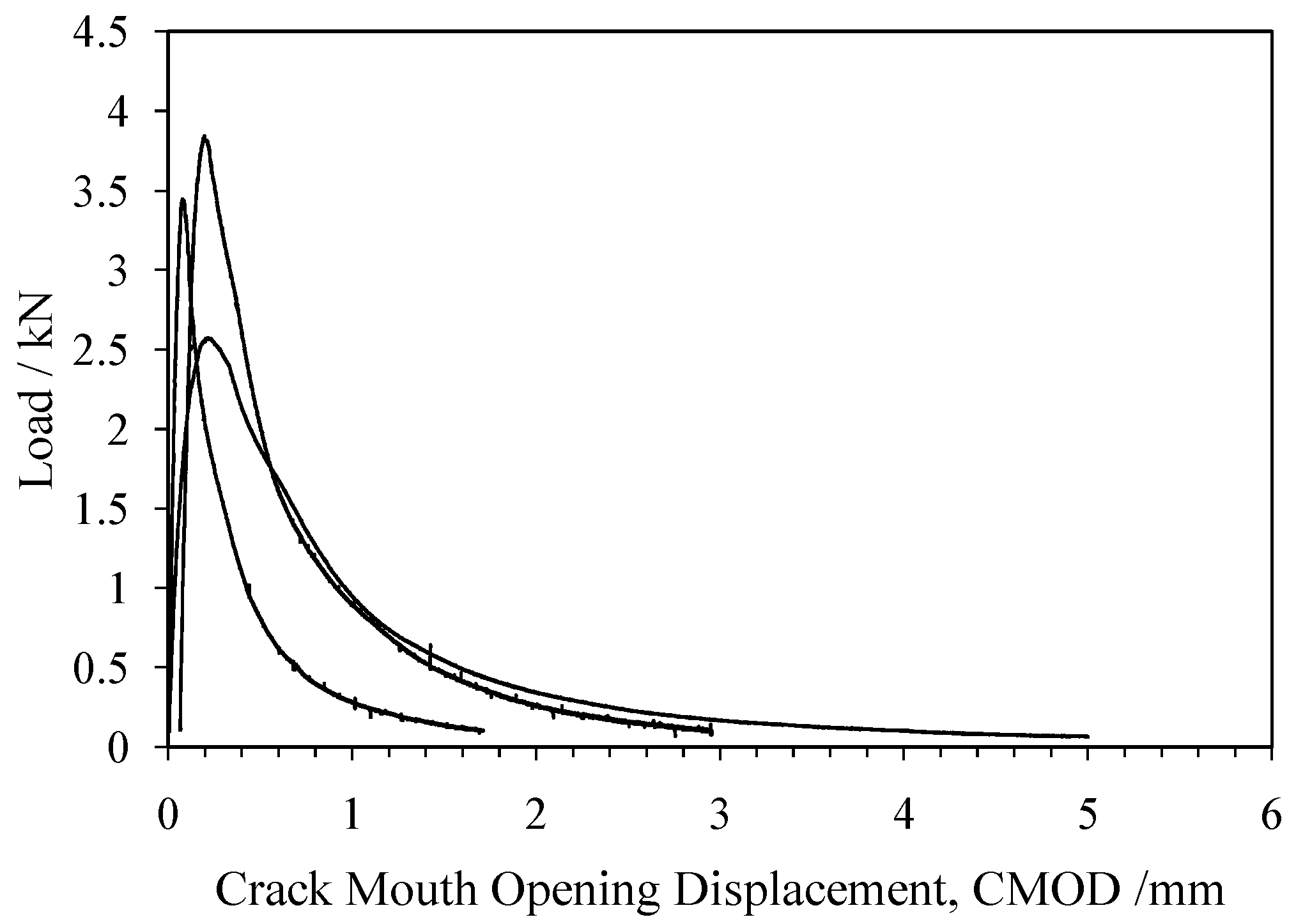
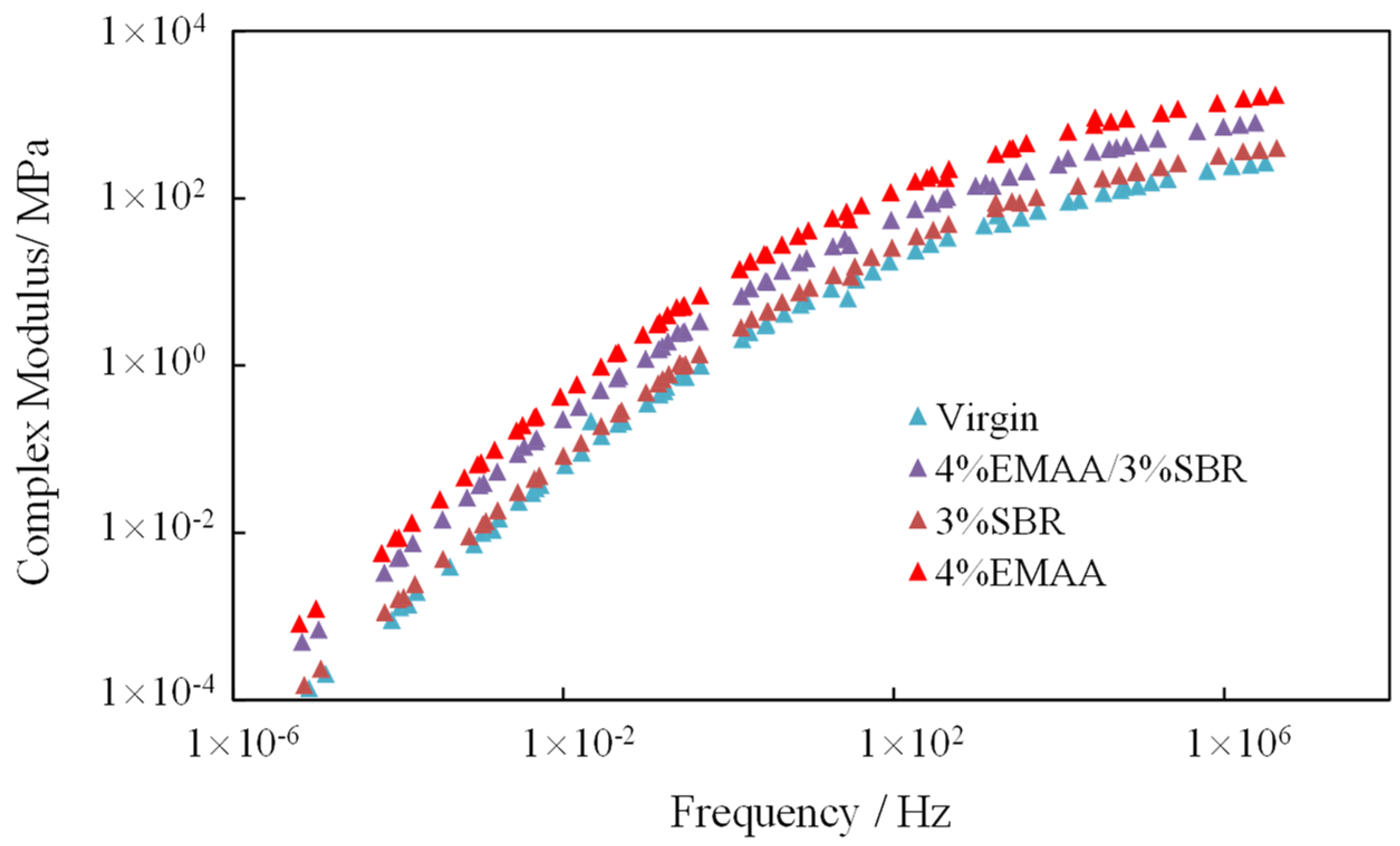
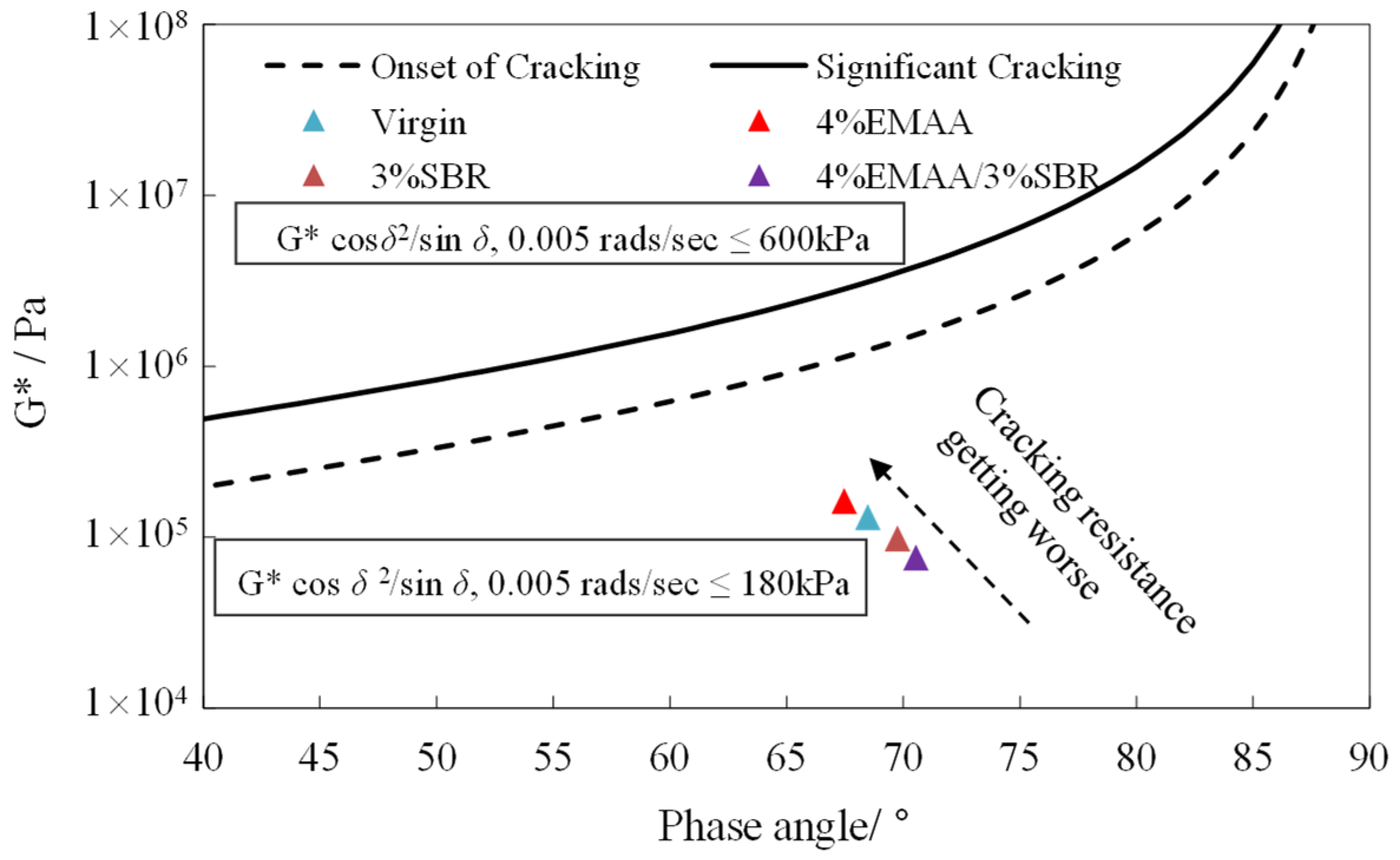
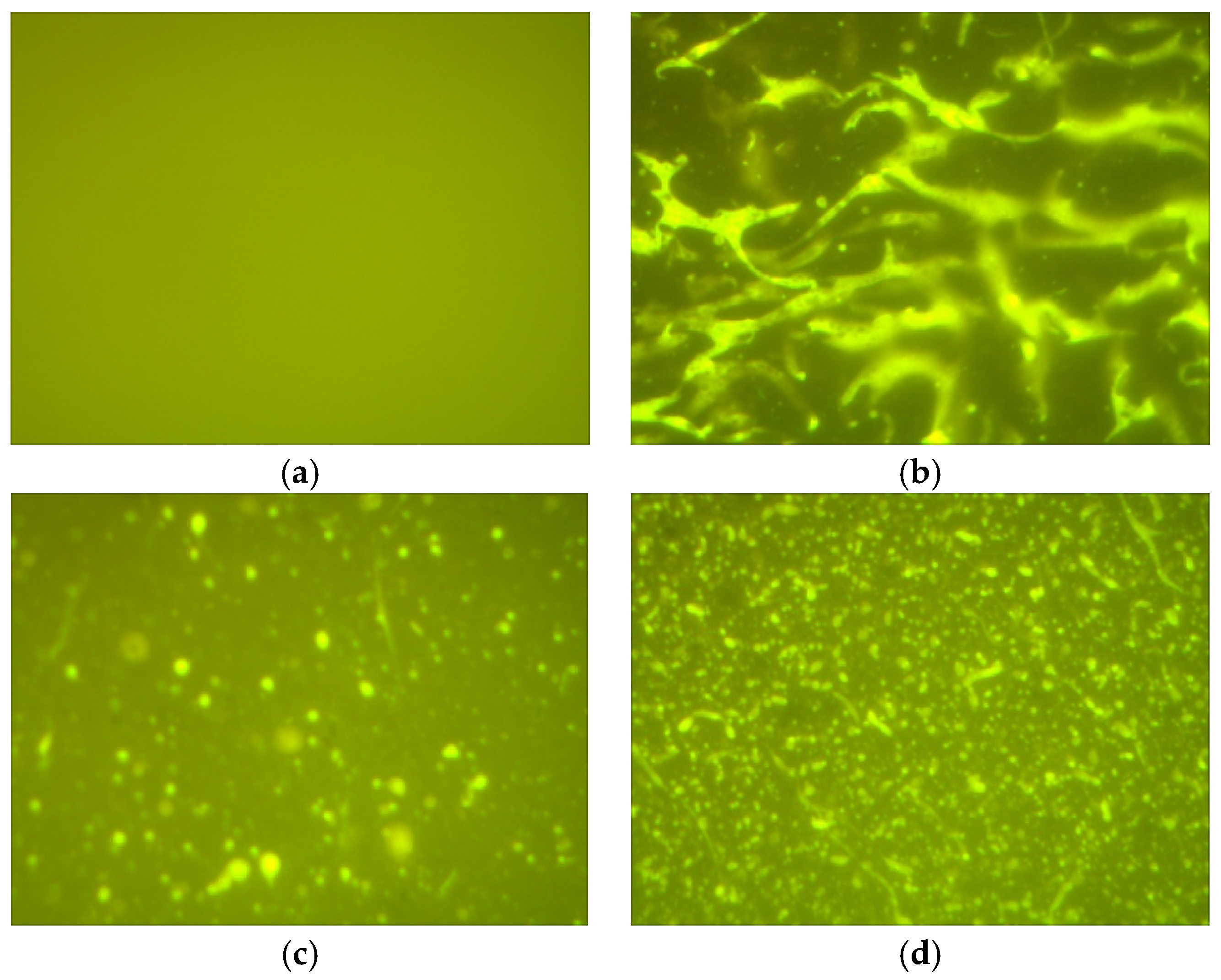

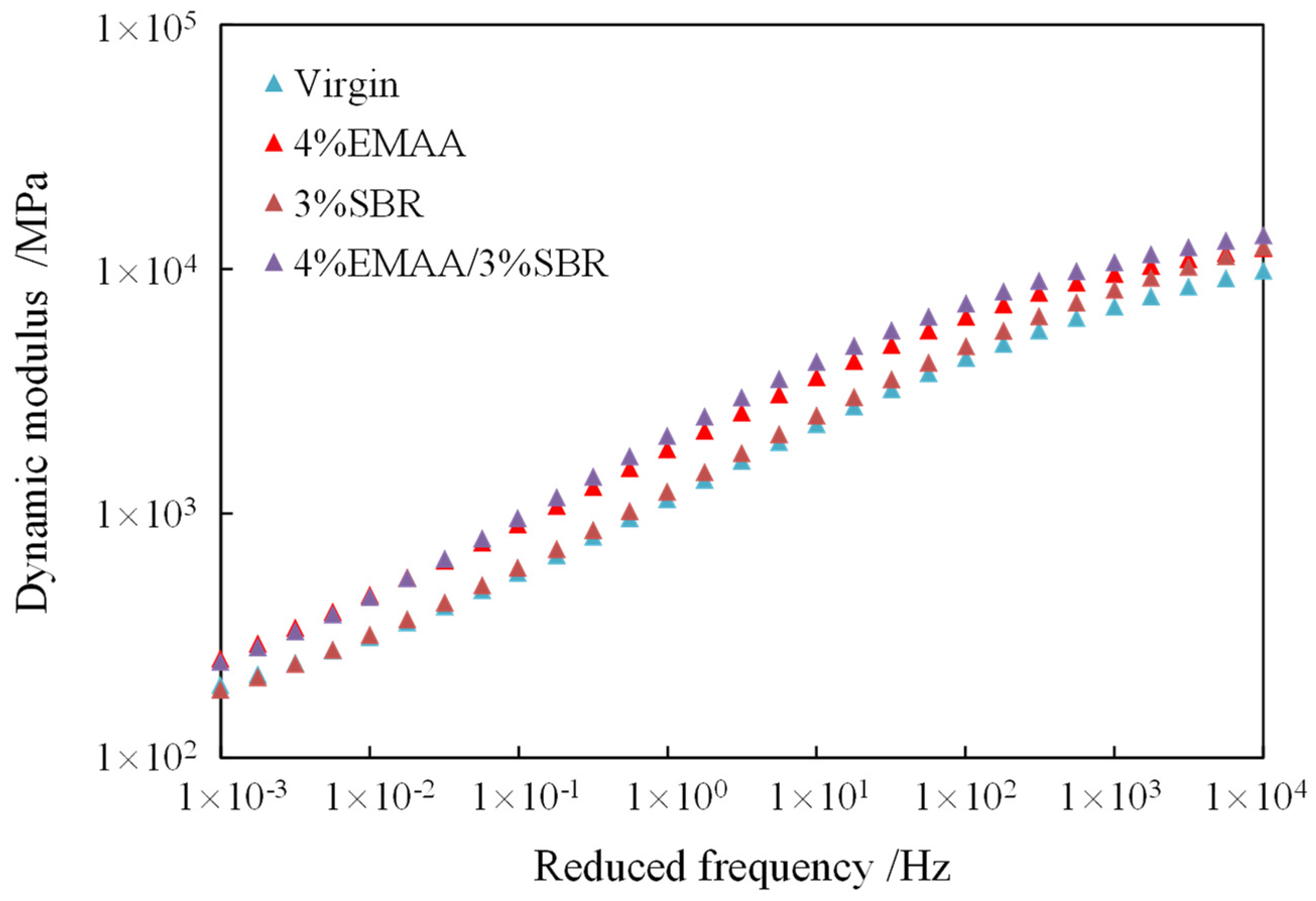
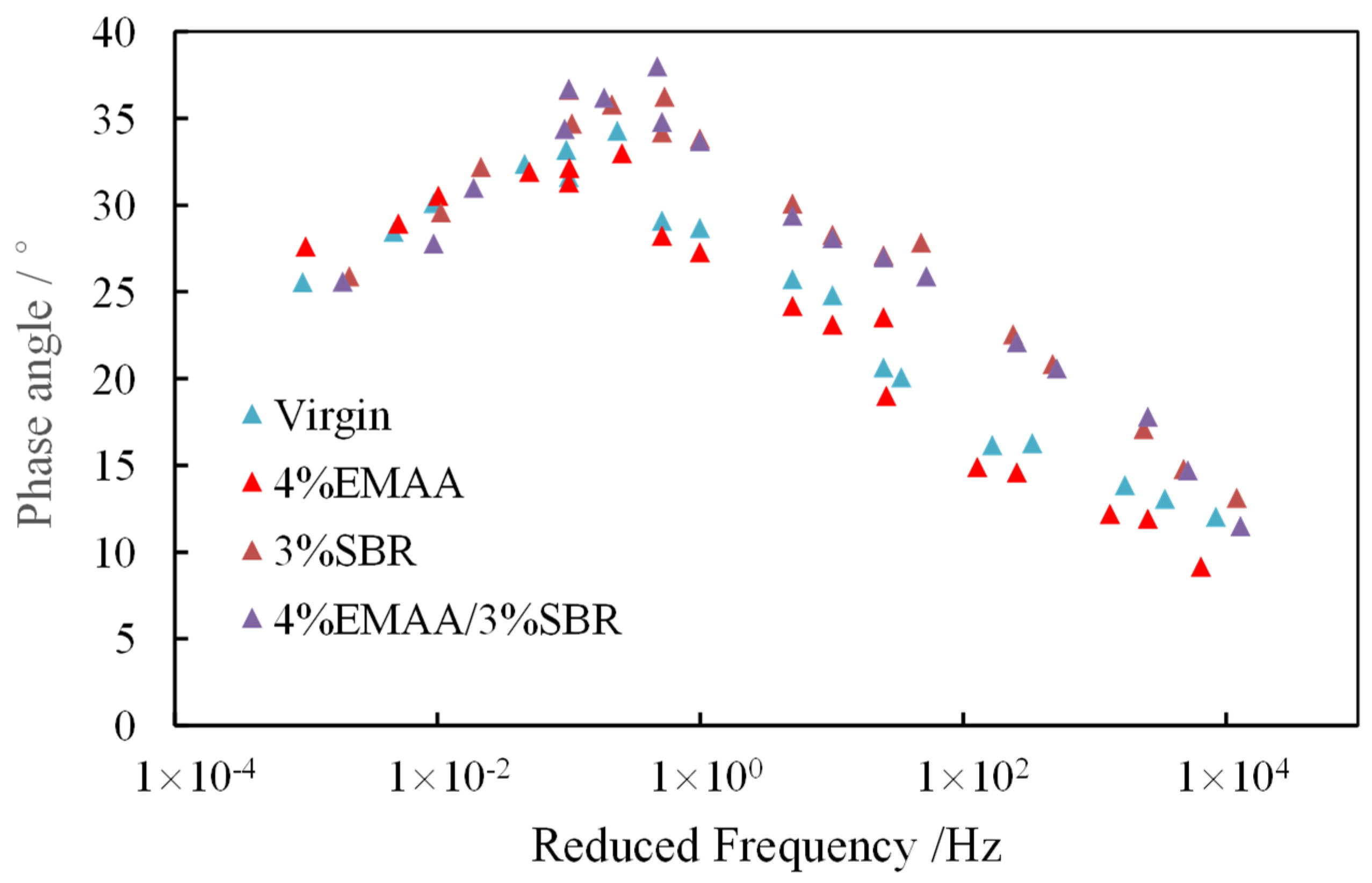
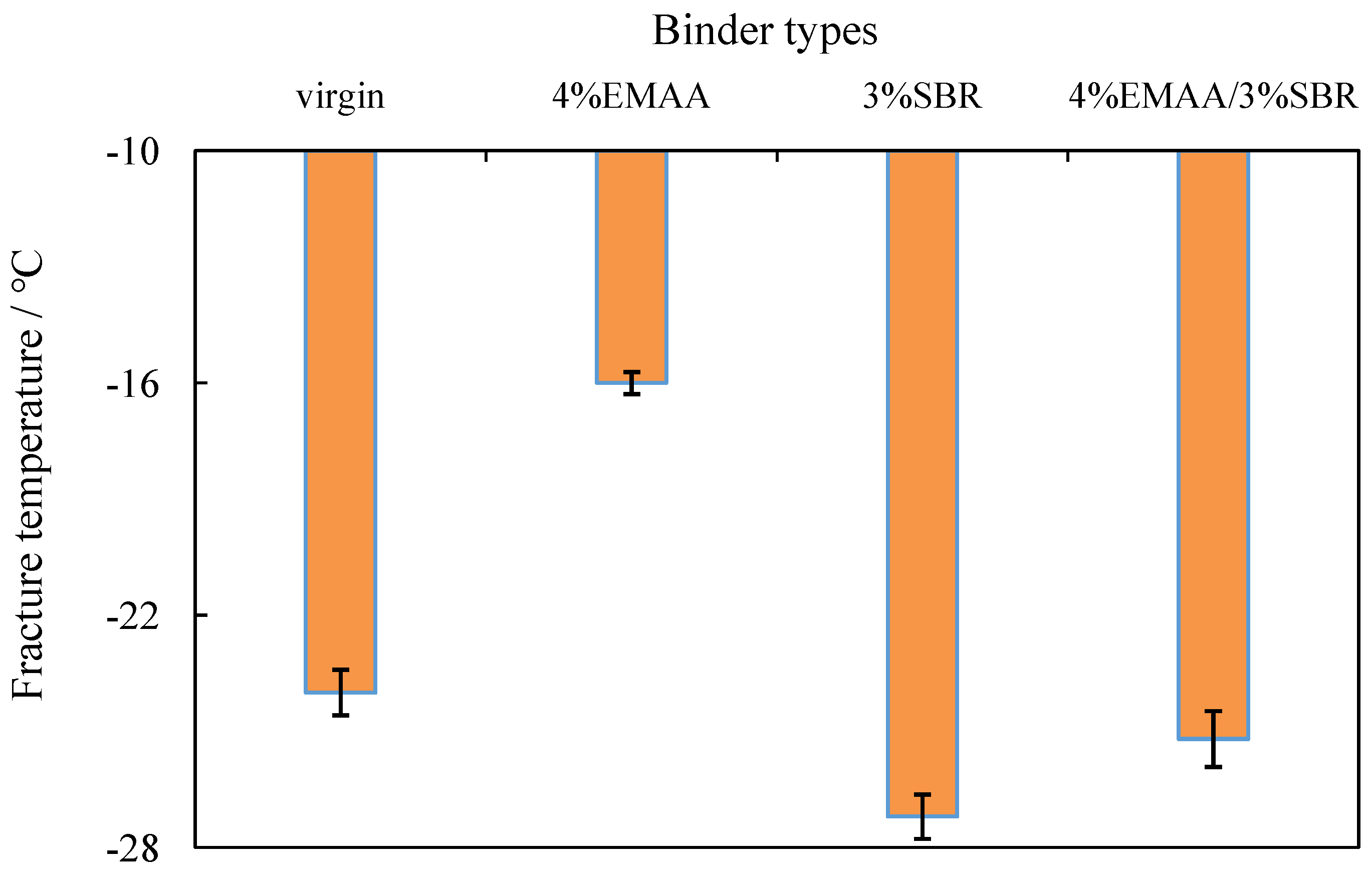

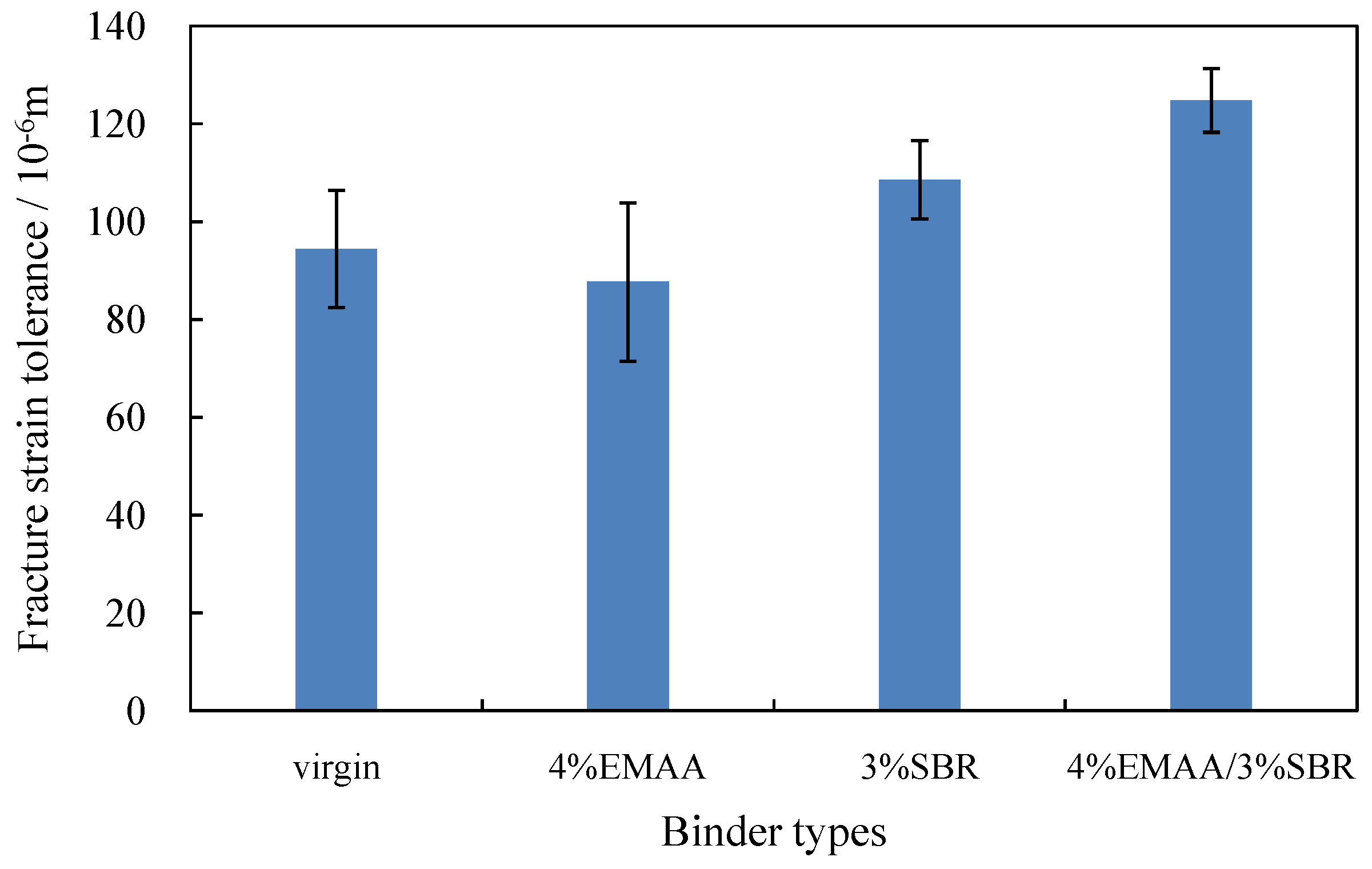
| Test Properties | Results | Requirement | |
|---|---|---|---|
| Penetration (25 °C, 100g, 5 s)/0.1 mm | 74.9 | 60~80 | |
| Softening point/°C | 46.7 | ≥46 | |
| Ductility (10 °C)/cm | 68.5 | ≥15 | |
| Rolling thin film oven (RTFO) | Mass loss/% | 0.60 | ≤0.80 |
| Penetration ratio/% | 71.5 | ≥61.0 | |
| Ductility (10 °C)/cm | 9.8 | — | |
| Test Properties | Results | Requirement | |
|---|---|---|---|
| Coarse aggregate | Crushed value/% | 11.8 | ≤26 |
| Los Angeles wear value/% | 10.6 | ≤28 | |
| Polished stone value/PSV | 43 | ≥42 | |
| Fine aggregate | Apparent relative density | 2.679 | ≥2.50 |
| Angularity/s | 42.7 | ≥30 | |
| Filler | Apparent density/(g·cm−3) | 2.761 | ≥2.50 |
| Water content/% | 0.4 | ≤1 | |
| Test Properties | Values | Standards |
|---|---|---|
| Particle size/mesh | <80 | GB/T8656 |
| Tensile strength/MPa | 22 | GB/T8656 |
| Styrene content/% | 17~19 | GB/T8658 |
| Mooney viscosity/(Pa·s) | 68 | GB/T8657 |
| Test Properties | Values | Standards |
|---|---|---|
| Density/(g/cm3) | 0.93 | ASTM D792 |
| Vicat softening temperature/°C | 65.0 | ASTM D1525 |
| Melting point/°C | 95 | ASTM D3418 |
| Tensile strength/MPa | 32 | ASTM D1238 |
| Binder Type | Softening Point/°C | Equivalent Softening Point (T800)/°C | Kinematic Viscosity (135 °C)/Pa⋅s | Ductility (10 °C)/cm |
|---|---|---|---|---|
| 3%SBR | 57.5 | 53.4 | 1.33 | >100 |
| 1% EMAA + 3% SBS | 65.5 | 56.9 | 1.45 | >100 |
| 2% EMAA + 3% SBS | 68.9 | 59.3 | 1.58 | >100 |
| 3% EMAA + 3% SBS | 73.2 | 61.9 | 1.73 | >100 |
| 4% EMAA + 3% SBS | 74.3 | 63.2 | 1.82 | >100 |
| 5% EMAA + 3% SBS | 75.0 | 64.3 | 1.89 | 92.3 |
| 6% EMAA + 3% SBS | 75.5 | 64.8 | 1.93 | 76.5 |
| Test Properties | Virgin | 4% EMAA | 3% SBR | 4%EMAA/3%SBR |
|---|---|---|---|---|
| Average LOriginal/(cm) | 15.2 | 12.8 | 16.2 | 20.3 |
| Average LHealed/(cm) | 19.2 | 18.9 | 21.9 | 31.2 |
| D/(%) | 26.3 | 47.7 | 35.2 | 53.7 |
| Asphalt Type | Stress Ratio | Nf/Cycles | N1/Cycles | N2/Cycles | (N1 + N2)/Cycles | H/% |
|---|---|---|---|---|---|---|
| Virgin | 0.5 | 20,158 | 6047 | 16,752 | 22,799 | 13.1 |
| 4% EMAA | 18,596 | 5578 | 19,256 | 24,834 | 33.5 | |
| 3% SBR | 31,596 | 9478 | 30,456 | 39,934 | 26.4 | |
| 4%EMAA/3%SBR | 36,525 | 10,957 | 40,258 | 51,215 | 40.2 |
© 2020 by the authors. Licensee MDPI, Basel, Switzerland. This article is an open access article distributed under the terms and conditions of the Creative Commons Attribution (CC BY) license (http://creativecommons.org/licenses/by/4.0/).
Share and Cite
Zhu, Y.; Rahbar-Rastegar, R.; Li, Y.; Qiao, Y.; Si, C. Exploring the Possibility of Using Ionic Copolymer Poly (Ethylene-co-Methacrylic) Acid as Modifier and Self-Healing Agent in Asphalt Binder and Mixture. Appl. Sci. 2020, 10, 426. https://doi.org/10.3390/app10020426
Zhu Y, Rahbar-Rastegar R, Li Y, Qiao Y, Si C. Exploring the Possibility of Using Ionic Copolymer Poly (Ethylene-co-Methacrylic) Acid as Modifier and Self-Healing Agent in Asphalt Binder and Mixture. Applied Sciences. 2020; 10(2):426. https://doi.org/10.3390/app10020426
Chicago/Turabian StyleZhu, Yuefeng, Reyhaneh Rahbar-Rastegar, Yanwei Li, Yaning Qiao, and Chundi Si. 2020. "Exploring the Possibility of Using Ionic Copolymer Poly (Ethylene-co-Methacrylic) Acid as Modifier and Self-Healing Agent in Asphalt Binder and Mixture" Applied Sciences 10, no. 2: 426. https://doi.org/10.3390/app10020426
APA StyleZhu, Y., Rahbar-Rastegar, R., Li, Y., Qiao, Y., & Si, C. (2020). Exploring the Possibility of Using Ionic Copolymer Poly (Ethylene-co-Methacrylic) Acid as Modifier and Self-Healing Agent in Asphalt Binder and Mixture. Applied Sciences, 10(2), 426. https://doi.org/10.3390/app10020426






